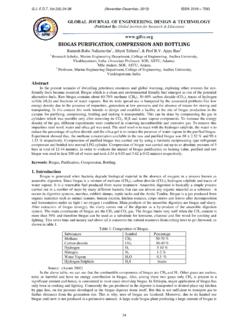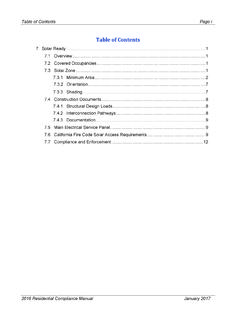Transcription of Biogas Plant Construction Manual
1 Biogas Plant Construction Manual Fixed-dome Digester: 4 to 20 Cubic Meters United States Forces Afghanistan, Joint Engineer Directorate Kabul, Afghanistan April 2011 Forward In July 2010 United States Forces Afghanistan (USFOR-A) were requested by General David H. Petraeus, Commander International Security and Assistance Force (COMISAF) to investigate the feasibility of Biogas technology in Afghanistan. The leading purpose for the rural application of Biogas is two-fold: alternative to burning manure and other organic material in the home, and returning nutrient-rich fertilizer to the land. Research show these attributes benefit human health and the environment. USFOR-A Joint Engineer Directorate worked closely with United States Agency for International Development (USAID), Islamic Republic of Afghanistan Ministry of Energy and Water Renewable Energy Department (Director Amir Mohammad Alamzai), Ministry of Rural Rehabilitation and Development, and Ministry of Agriculture, Irrigation and Livestock to investigate existing Biogas technology in Afghanistan, identify competent contractors designing and constructing Biogas digesters, and identify facilities and institutions with the potential to incorporate Biogas technology.
2 Director Alamzai provided USFOR-A contacts at the non-profit organization Agency for Rehabilitation & Energy Conservation in Afghanistan (AREA). AREA had demonstrated experience and knowledge in the design, Construction and operation of Biogas plants in several provinces of Afghanistan, specifically the fix-dome Biogas digester made popular in Asia. USFOR-A contracted AREA to design, construct and operate an 8-cubic meter Biogas Plant at the Renewable Energy Department, Kabul in the winter and spring of 2010-2011. The Biogas Plant was completed in six weeks and fed dairy cow manure and water. The Manual is based on both the Gobar Biogas Plant and the performance by AREA during the Construction of the Biogas Plant in Kabul. We sincerely appreciate the support and direction from General Petraeus, Major General Timothy McHale (USFOR-A Deputy Commander for Support), Brigadier General Buckler (Director JENG), Brigadier General Mark Yenter (Director JENG), Brigadier General Mark Martins (Rule of Law Field Force), Colonel Louis Dell Orco, Lieutenant Colonels Dallas Olson, Butch Welch and Robert Tucker, PhD (JENG), Mr.
3 Abdul Rasool Wardak and the folks with US Agency for International Development. We also appreciate the skill and work of Staff Sergeant Jeffrey Hart for turning rough sketches into professional Engineer designs and the financial process support of Captain Moses Wearing to ensure funding of this project through the Commander s Emergency Response Program. We learned much about the practical design and Construction of the Biogas Plant from Engineer Khail Shah and Engineer Arif Ulla Azimi of AREA and have shared these lessons in this Manual . We especially thank Director Alamzai for his support and leadership to guide and direct the project at his facility in Kabul and of course thank the citizens of the United States of America for granting us the resources to accomplish this and many other projects to improve the security and legitimacy of the Government of the Islamic Republic of Afghanistan.
4 Edward T. Mears Roger H. Anderson MAJ, EN, USA MSG, EN, USA ii Table of Contents 1. Introduction .. 1 2. Determining Plant Size .. 1 3. Selection of Construction 4 Cement .. 5 5 Gravel .. 5 Water .. 5 Bricks .. 5 Cobble Stones .. 6 4. Construction Site Selection .. 6 5. Site Layout .. 6 6. 7 7. Construction of Digester Main Chamber .. 8 8. Dome Construction .. 11 9. Outlet Chamber Construction .. 15 10. Construction of Inlet Tank .. 17 11. Lay-out of Pipeline .. 18 12. Compost Pits .. 19 13. Biogas Appliances .. 20 14. Solar Water Heater .. 21 .. 24 Attachment A Operation and Maintenance of Biogas Plant iii iv Tables Table Plant size and average daily feedstock. Table Dimensions for the Various Plant Sizes from the Design in Figure Table Biogas Plant Construction Materials Figures Figure Gobar Biogas Plant Design Figure Schematic for Condensate Drain Valve in Gas Line.
5 Figure AREA Biogas Model Design Biogas Plant Construction Manual April 2011 United States Forces - Afghanistan Page 1 of 24 1. Introduction A Biogas Plant is an anaerobic digester of organic material for the purposes of treating waste and concurrently generating Biogas fuel. The treated waste is a nutrient-rich, nitrogen-rich fertilizer while the Biogas is mostly methane gas with inert gases including carbon dioxide and nitrogen. Biogas plants are a preferred alternative to burning dried animal dung as a fuel and can be used for the treatment of human waste. Other feedstock which can be used includes Plant material, non-meat or grease food-wastes, and most types of animal dung. Over a million Biogas plants have been constructed in the developing world for treatment of organic wastes, alternative energy supply to direct burning in the home, and overall improvement of human health and the environment.
6 Many factors for selection of feedstock and site location must be researched before deciding to install a Biogas Plant . Successful Construction of the Biogas Plant requires a proper design and adherence to follow correct Construction methods. The success or failure of any Biogas Plant primarily depends upon the quality of Construction work. The following instructions are based on the step-by-step instructions from the Government of Nepal Biogas Support Program Gobar Gas and Agricultural Equipment Development Company of Nepal has developed the design for model 2047 Biogas Plant . This Biogas Plant model has become prolific across Asia and is known as a fixed-dome Plant . The advantages of the fixed dome Plant include the simplicity of design, few moving parts, low cost to construct and low maintenance. The disadvantages when compared to a floating-dome digester are primarily the inability to store gas for use on demand; gas from the fixed dome digester must be used as generated or expelled to avoid damaging the digester.
7 2. Determining Plant Size This Manual includes design and Construction material quantities for the Gobar Biogas Plant models of 4, 6, 8, 10, 15 and 20 cubic meters capacity. Design and size of a Plant other than mentioned above is feasible and a skilled engineer should be consulted for deviations from the provided designs. The Biogas Plant size is dependent on the average daily feed stock and expected hydraulic retention time of the material in the Biogas system. Generally, 24 kilograms of feedstock complimented with 24 liters of water per day with a hydraulic retention time of 35 days will require a 4-cubic meter Plant . Table below gives some relevant data about the six different sizes of Biogas plants presented in this Manual . Biogas Plant Construction Manual April 2011 United States Forces - Afghanistan Page 2 of 24 Table Plant size and average daily feedstock.
8 Plant Size (m3) Daily Feedstock (kilogram) Daily Water (liters) 4 24 24 6 36 36 8 48 48 10 60 60 15 90 90 20 120 120 Plant size is the sum of digester volumne and gas storage. Based on a hydraulic retention time of 35 days. The Biogas Plant detailed in this Manual consists of five main structures or components: 1. Inlet Tank; 2. Digester Vessel; 3. Dome; 4. Outlet Chamber; and 5. Compost Pits. The required quantity of feedstock and water is mixed in the inlet tank and the slurry is discharged to the digester vessel for digestion. The gas produced through methanogenesis in the digester is collected in the dome. The digested slurry flows to the outlet tank through the manhole. The slurry then flows through the overflow opening in the outlet tank to the compost pit. The gas is supplied from the dome to the point of application through a pipeline. Photo : Scale Model of 4 Cubic-Meter Biogas Plant for Training (Camp Nathan Smith, Kandahar, Afghanistan) When a Biogas Plant is underfed the gas production will be low; in this case, the pressure of the gas might not be sufficient to fully displace the slurry in the outlet chamber.
9 It is important to design the Plant keeping hydrostatic pressure higher at the inlet tank than the outlet tank. The hydrostatic pressure from slurry in the inlet and outlet tanks will pressurize the Biogas Biogas Plant Construction Manual April 2011 United States Forces - Afghanistan Page 3 of 24 accumulated in the dome. If too much material is fed into the digester and the volume of gas is consumed, the slurry may enter the gas pipe and to the appliances. Figure : Gobar Biogas Plant Design Table : Dimensions for the Various Plant Sizes from the Gobar Gas Design in Figure Biogas Plant Construction Manual April 2011 United States Forces - Afghanistan Page 4 of 24 3. Selection of Construction Materials If the materials used in the Plant Construction such as cement, sand, aggregate etc. are not of good quality, the quality of the Plant will be poor even if the design and workmanship are excellent.
10 A brief description regarding the specifications for some of the Construction materials is provided below to assist with selection of the best quality materials. The list of Construction materials is given in Table Table Biogas Plant Construction Materials Biogas Plant Construction Manual April 2011 United States Forces - Afghanistan Page 5 of 24 Cement The cement to use in the Plant Construction must be of high quality Portland cement from a brand with a known reputation. It must be fresh, without lumps and stored in a dry place. Bags of cement should never be stacked directly on the floor or against the walls to protect the cement from absorbing moisture before use. Sand Sand for Construction purpose must be clean. Dirty sand has a very negative effect on the strength of the structure. If the sand contains 3% or more impurities by volume, it must be washed.









